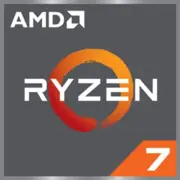AMD Ryzen 7 PRO 3700

AMD Ryzen 7 PRO 3700: A Processor for Balancing Performance and Efficiency
Relevant as of April 2025
Key Features: Architecture and Unique Characteristics
The AMD Ryzen 7 PRO 3700 processor, released in 2020, remains relevant in 2025 due to its successful combination of features.
Zen 2 Architecture and 7nm Process
The chip is based on the Zen 2 microarchitecture, manufactured using the TSMC 7nm FinFET process. This ensures high transistor density and energy efficiency. Despite the emergence of newer Zen 4 and Zen 5 architectures, Zen 2 continues to be popular for budget builds and corporate solutions.
- 8 cores and 16 threads with a base clock of 3.6 GHz (maximum boost up to 4.4 GHz).
- 32 MB L3 cache — an advantage for latency-sensitive tasks (rendering, code compilation).
- TDP 65W — low power consumption for its class.
Performance
In the Geekbench 6 benchmark, the processor shows:
- 1666 points in single-core mode;
- 8172 points in multi-core.
This makes it comparable to the Intel Core i7-11700, but with lower heat generation.
Key Features of the PRO Series
- AMD PRO Technologies: Hardware protection against threats (Secure Processor, Memory Guard);
- Enhanced support for enterprise management systems (DASH, Manageability);
- 36 months warranty and extended support cycle.
Compatible Motherboards: AM4 Socket and Chipsets
The Ryzen 7 PRO 3700 uses the AM4 socket, which limits the choice of motherboards to models relevant from 2020-2022.
Recommended Chipsets
1. B550: The optimal choice for most users.
- Supports PCIe 4.0 for SSDs and graphics cards;
- Examples of boards: MSI B550 Tomahawk ($120–$150), ASUS TUF Gaming B550-PLUS ($130–$160).
2. X570: For enthusiasts needing advanced features.
- More PCIe 4.0 lanes, improved VRM;
- Examples: Gigabyte X570 AORUS Elite ($180–$220).
Selection Considerations
- BIOS Update: Boards from 2020-2021 may require an update for compatibility.
- VRM: A 6-phase power supply is sufficient for stable operation.
Supported Memory: DDR4 and Its Nuances
The processor does not support DDR5, which may be considered a drawback in 2025. However, DDR4 remains accessible and affordable.
- Officially Supported Frequencies: Up to 3200 MHz (without overclocking).
- Recommendations:
- The optimal choice is DDR4-3600 CL16 kits (e.g., Crucial Ballistix, $60–$80 for 32 GB);
- For professional tasks — 64 GB (2×32 GB) DDR4-3200.
Power Supply: Calculations and Recommendations
With a TDP of 65W, the processor is not demanding in terms of power, but it’s important to consider other components.
- Minimum PSU Power: 450–500 W (for a system with a graphics card like the NVIDIA RTX 3060).
- Recommended Models:
- Be Quiet! Pure Power 12 M 550W ($70–$80) — quiet and reliable;
- Corsair CX650M ($75–$85) — for systems with RTX 4070.
- Tip: Don't skimp on certifications (80+ Bronze or higher).
Pros and Cons of Ryzen 7 PRO 3700
Advantages
- Energy efficiency (65W compared to 125W for similar models);
- High multi-threaded performance;
- Low cost ($220–$250 in 2025).
Disadvantages
- Lack of PCIe 5.0 and DDR5;
- Zen 2 architecture lags behind Zen 4 in single-threaded tasks;
- No integrated graphics.
Use Case Scenarios: Where the Processor Excels
Office and Corporate Environment
- Running virtual machines, working with databases;
- Secure PRO features for handling confidential data.
Content Creation
- Rendering in Blender: 8 cores handle medium complexity projects in acceptable time;
- Video editing in DaVinci Resolve: 32 MB cache accelerates effects processing.
Gaming
- Paired with RTX 4060: 60+ FPS in Full HD (Cyberpunk 2077, Horizon Forbidden West);
- A bottleneck exists in single-threaded performance in CPU-bound games (e.g., Microsoft Flight Simulator).
Comparison with Competitors
AMD Ryzen 7 5700X (Zen 3)
- Pros: +15% IPC, PCIe 4.0 support;
- Cons: Price ($280–$300), TDP 65W.
Intel Core i7-12700F
- Pros: 12 cores (8P+4E), DDR5;
- Cons: TDP 125W, cost ($300–$330).
Conclusion: The Ryzen 7 PRO 3700 excels in the budget segment but lags in core performance compared to newer models.
Practical Assembly Tips
1. Cooling: The stock cooler will suffice, but for quieter operation, choose a DeepCool AK400 ($30).
2. Motherboard: B550 + PCIe 4.0 SSD (e.g., Samsung 980 Pro) — ideal balance.
3. Upgrade: Keep in mind that AM4 is a "dead" socket. The next step is transitioning to AM5.
Example build for $800:
- Processor: $230;
- Motherboard: $140;
- Memory: 32 GB DDR4 — $70;
- Graphics Card: RX 7600 XT — $280.
Final Conclusion: Who Should Consider the Ryzen 7 PRO 3700?
This processor is a good choice if:
- Budget is limited, but multi-threaded performance is required;
- PRO features for business are essential;
- Energy efficiency is more important than maximum performance.
In 2025, the Ryzen 7 PRO 3700 is a solid option for office workstations, home servers, and budget gaming PCs. However, for modern AAA games or work with neural networks, it is advisable to consider newer processors.
Basic
CPU Specifications
Memory Specifications
GPU Specifications
Miscellaneous
Benchmarks
Compared to Other CPU
Share in social media
Or Link To Us
<a href="https://cputronic.com/index.php/cpu/amd-ryzen-7-pro-3700" target="_blank">AMD Ryzen 7 PRO 3700</a>